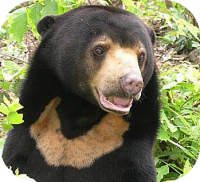|
Sun Bears are omnivorous mammals.
|
Sun Bear
Classification:
Kingdom: Animalia
Phylum: Chordata
Class: Mammalia
Order: Carnivora
Family: Ursidae
Genus: Ursus
Species: Malayanus
|
Other Names: Dog Bear, Malay
Bear, Ape Man, Malayan Sun bears,
and Honey Bear
Sub-Species: There are two
sub-species of sun bears they include:
Sun Bear - Helarctos malayanus
malayanus
Borneo Sun Bear - Helarctos
malayanus euryspilus |
Size: The sun bear is the
smallest of the world's eight bear
species. Sun bears weigh 60
to 150 lbs, and are 4-5 feet tall.
Males are typically 10-20% larger
than their female counterparts.
Habitat: Sun bears inhabit
Southeast Asia. Sun bears are found
in the tropical forests of Thailand,
Cambodia, Vietnam, Laos, Burma, the
Malay Peninsula, Sumatra, and Borneo
in Asia.
Diet: Sun bears exist on a
diet consisting mostly of termites,
birds, small mammals, beetle larvae,
bee larvae, honey, and a large variety
of fruits.
Senses: Sun Bears have good
hearing.
Description: Sun bears have
a stocky muscular build, with small
ears and a protruding short snout.
Sun bears have a short black coat,
with a crescent shaped patch of white
or yellowish fur on their chest and
lighter colored fur on their muzzle
and snout. The thick short, dense
coat repels the rain, mud, and other
debris. Their feet are turned inward.
Sun bears have long sharp curved claws
that can be up to four inches long,
that they use for climbing. Sun bears
have an extremely long tongue that
they use to extract honey from hives
and insects from trees.
Behavior: Sun bears are arboreal
and spend a fair amount of times in
trees.
|

Sun Bear
Conservation Classification:
Vulnerable / Critical Risk /
Endangered


|